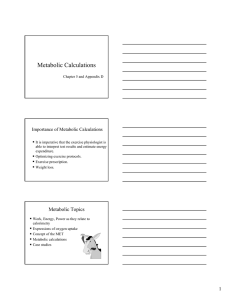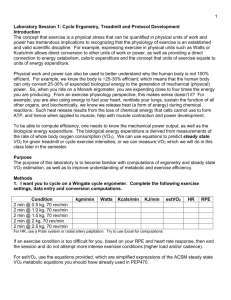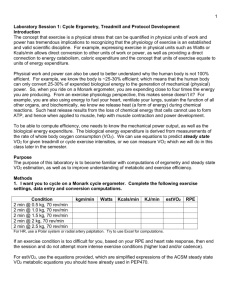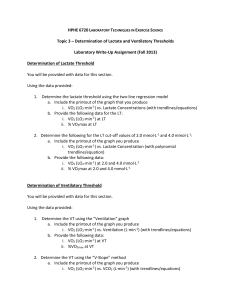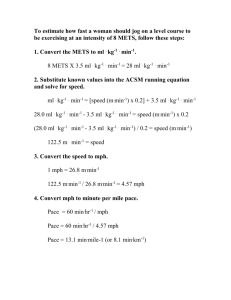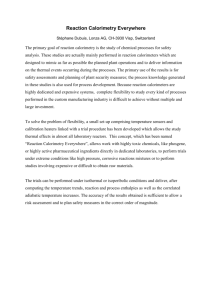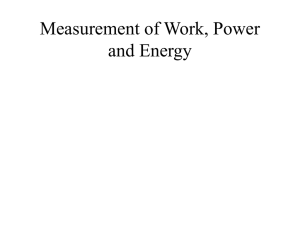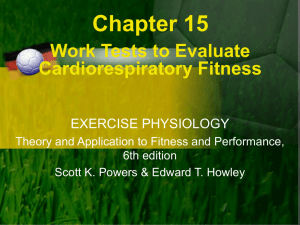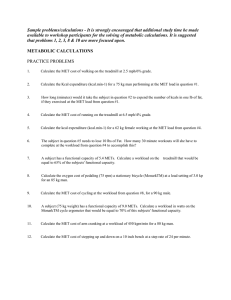Metabolic Calculations - Tarleton State University
advertisement
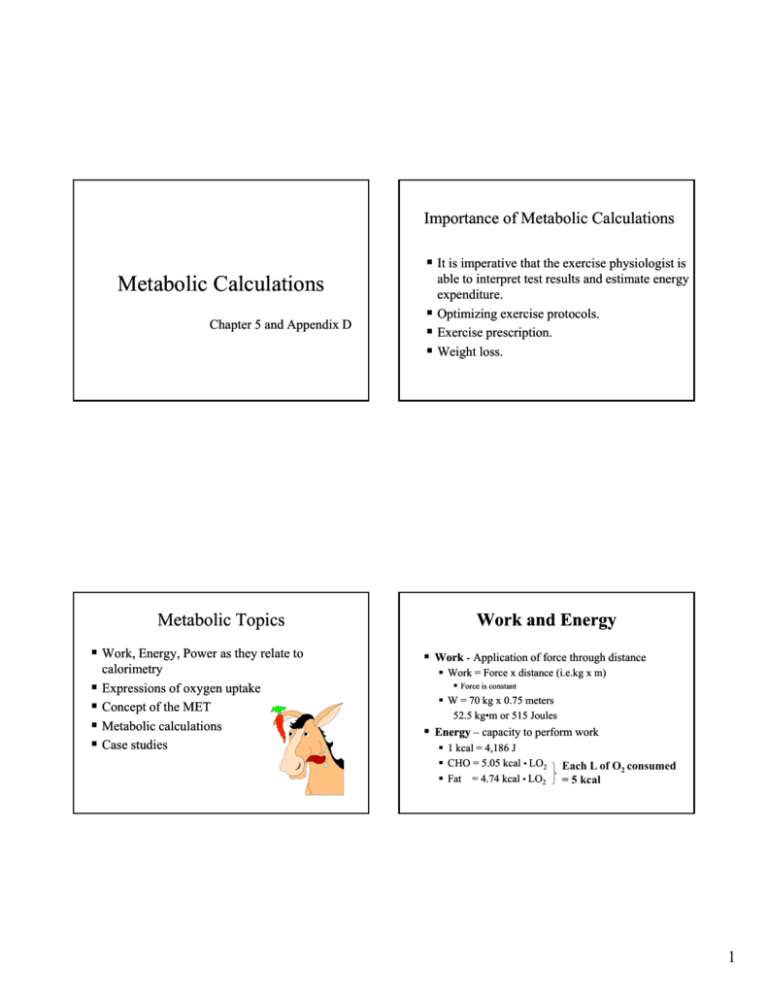
Importance of Metabolic Calculations It is imperative that the exercise physiologist is Metabolic Calculations Chapter 5 and Appendix D Metabolic Topics Work, Energy, Power as they relate to calorimetry Expressions of oxygen uptake C Concept off the h MET Metabolic calculations Case studies able to interpret test results and estimate energy expenditure. di Optimizing exercise protocols. Exercise prescription. Weight loss. Work and Energy Work - Application of force through distance Work = Force x distance (i (i..e.kg x m) Force is constant W = 70 kg x 0.75 meters 52..5 kg 52 kg••m or 515 Joules Energy – capacity to perform work 1 kcal = 4,186 J CHO = 5.05 kcal • LO2 Fat = 4.74 kcal • LO2 Each L of O2 consumed = 5 kcal 1 Power (on different modes) • Power – Amount of work per unit time • Bike • work/time (I.e. kgm/min; Watt) • 1 W = 6 kgm•min-1 • Note = For cycle l ergometry you must account for f • kg • distance the flywheel moves the kg with one turn • rev•min-1 • I.e. Monarch = 6 m • rev -1 • Power = (2 kg x 6 m • rev -1 x 60 rev•min-1) = 720 kgm•min-1 or W Power (on different modes) • Power – Amount of work per unit time • Step – • step height (m) • 4 cycle steps / minute (f) • Treadmill • Speed (m/min) • Grade (% grade – use decimal) Energy Expenditure Understanding energy expenditure is important for weight loss, work tasks, exercise pprescription, p , etc. Calorie - basic unit of measure of energy expenditure Direct and Indirect Calorimetry can be used to estimate energy expenditure Calorimetry Direct Calorimetry Metabolic Chamber (enclosed) Slide 8 Indirect Calorimetry Closed or Open Circuit Spirometry Indirect Calorimetry, Slide 11, Slide 10 2 Calorimetry Calorimetry Indirect Calorimetry Calorimetry Calorimetry 3 Indirect Calorimetry: Variables Obtained Oxygen consumption and carbon dioxide production (VO2, VCO2) Respiratory exchange ratio (RER (RER or R) R)- Noninvasive method to estimate the relative contribution of fat and CHO to energy metabolism RQ during steady state conditions VCO2/VO2 Calorie/ energy expenditure Need a link In research and in practice, we use information obtained from openopen-circuit spirometry to give us estimates of energy expenditure, aerobic power and fuel utilization. power, utilization For example, we can use oxygen consumption measures to help us determine caloric expenditure during exercise. i.e. 1 liter of VO2 = ~ 5 kcals For example: How many calories are you burning if you exercise in a step class using an 8 inch bench? If we need to know the oxygen consumption (workload) for someone exercising at 6 mph at 5% grade….. If we need to figure out, how long it will take an individual to loose a certain amount of weight…. 4 Expressions for O2 uptake (VO2) Expressions for O2 uptake (VO2) We will be using metabolic calculations to calculate oxgyen consumption and calories Oxygen consumption in humans can be expressed in two different forms Absolute – (L (L··min-1 or ml ml··min-1): Can be used in a form that will yield rate of energy expenditure (1 L of O2 = 5 kcal) Relative – (ml (ml•kg •kg-1•min-1): used to compare individuals of different body size and to better quantify aerobic fitness level MATH AND UNITS ?? Make sure that you have your answer is in the right units. Make sure your answer units make physiological sense Make sure your answer units agree with the problem (i.e. apples = apples NOT apples = oranges) Make sure you cancel out units correctly i.e. 3 L/K X 5 K/ P = 15 L/Ps Absolute – (L (L··min-1 or ml ml··min-1): Can be ! UNITS UNITS usedUNITS in a form that will! yield rate!of energy expenditure ; good for converting oxygen consumption into calories (1 L of O2 = 5 kcal) Relative – (ml (ml•kg •kg-1•min-1): used to compare individuals of different body size and to better quantify aerobic fitness level Example 5 apple/oranges X 6 orange/ bananas = ??? 30 apple / bananas ÷ 6 oranges = ??? 5 apple/ banana/ oranges Expressions of units a/ b/ c is the same as a•b-1•c-1 5 MET METs Clinically, the MET or “Metabolic equivalent” is used to express energy expenditure and to prescribe exercise in clinical settings. settings. 1 MET = 3.5 ml• ml•kgg-1•min-1 For example 80 kg man working at 2.5 L•min-1 2,500 mL•min mL•min-1 / 80kg = 31.25 ml ml••kg-1•min-1 1 1 31.25 ml• ml•kg •min / 3.5 = 8.9 METs Met Calc warming up Man weighing 200 lbs has pk O2 uptake = 4.0 L•min-1 What is his relative oxygen consumption? How many METs is this? A woman weighing 155 lbs has VO2 pk = 32.1 ml ml••kg -1 • min-1 What is her absolute oxygen uptake? How many METs is this? What is the difference between indirect and direct calorimetry?? calorimetry 6 Practice with O2 calculations Man weighing 176 lbs has pk O2 uptake = 4.4 L•min-1 What is his relative oxygen consumption? How many METs is this? A woman weighing i hi 140 lbs lb has h VO2 pkk = 36.7 36 7 ml ml••kg -1 • min-1 What is her absolute oxygen uptake? How many METs is this? How many METs would 70% of her peak capacity be equivalent to? How many calories per minute is she burning at her peak? How many calories per minute is she burning at 70%? ACSM Metabolic Calculations Can estimate energy expenditure if you have Vertical component Horizontal component Resting component Useful conversions (Memorize) / Always convert lb to kg (lb/2.2) Centimeters C i = in i x 2.54 2 54 Convert speed from mph to m/min (mi/h X 26.8) 1Watt = 6 kgm•min kgm•min-1 Remember equivalents Watts to kgm •min-1 kcals (3,500 kcals = 1 lb of fat gain or loss) 1 L O2 = 5 kcals For weight loss purposes, always account for resting metabolic rate, weekly physical activity and energy expenditure, and food intake Estimation of Energy Expenditure We can estimate energy expenditure through American College of Sports MedicineSM Metabolic Equations Special considerations for these equations Need N d tto assure th thatt person is i att steady t d state t t in i order d to t use equations There is a variance in prediction Need to consider environmental considerations No rail rail--holding and make sure equipment is calibrated Gross Vs. Net O2 cost Metabolic Calculations – (see also page 216) Walking (S=Speed; G=Grade) VO2 = (0.1• (0.1• S) + (1.8 • S • G) + 3.5 Treadmill and Outdoor Running VO2 = (0.2• (0.2• S) + (0.9 • S • G) + 3.5 Leg L Ergometry E t (watch ( t h the th units it here) h ) VO2 = (10.8 • W • M-1) + 7 OR VO2 = ((kgm ((kgm • min-1) • 2) + (3.5 • W) Arm Ergometry VO2 = (18 • W • M-1) + 3.5 Stepping VO2 = (0.2 (0.2•• F) + (1.33 • 1.8 • H • f) + 3.5 7 Break it down – Walking equation oxygen consumption (ml/kg/min) VO2 = [(0.1• [(0.1• S)] + [(1.8 • S • G)] + 3.5 Horizontal component – i.e. oxygen cost of Speed (units are Speed (units are carrying m/min) m/min) body in horizontal direction over distance Vertical component – i.e. (units are ml/kg/m) oxygen cost of carrying body in vertically(units are ml/kg/m) grade Resting oxygen consumption (ml/kg/min) Useful calculation tips to live by Practice Calculation (from pg 311) Write down all known’s and do any necessary A 7171-yearyear-old man weighing 180 lb walks on a conversions first. Calculate each component separately, then complete the calculation I.e. vertical, horizontal, resting Make sure your answer agrees with the motor--driven treadmill at 3.5 mph and a 15% motor grade. What is the oxygen consumption What is the MET level How many calories is he burning at this level? question in numerical and unit form (always provide units!!!) 8 …and Even More Practice Calculations - bonus More Practice Calculations A client weighs 155 lbs was determined to have a VO2 pk of 45 ml/kg/min. What is his oxygen consumption in absolute terms? In METs? How many kcals kcals/min /min is he expending? expending? A 2323-yearyear-old woman weighing 150 lb jogs on a motormotor-driven treadmill at 5.8 mph and a 0% grade. What is the oxygen consumption? What is her MET level? How many kcals kcals/min /min is she expending? A cardiac patient has just entered your cardiac rehabilitation program and has an exercise prescription to exercise 40 minutes at 6 METs, 4 days per week and the client weight 210 lbs. Calculate the following Treadmill grade for a speed of 2.5 mph Step rate for a 4 inch bench Resistance for a monarch bike at 50 rpm Total caloric expenditure for each workout session 9
